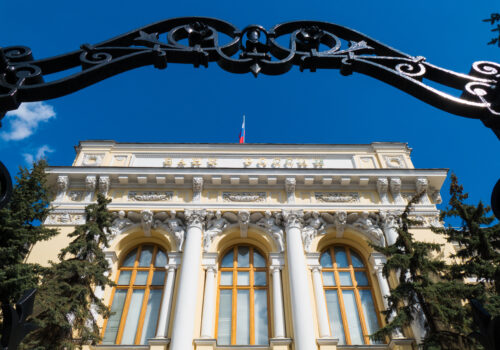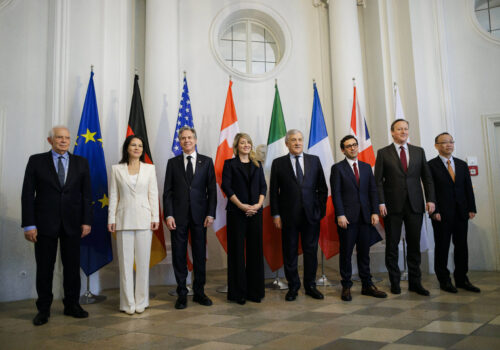‘Creative solutions’ with Russia’s immobilized assets must rise to the challenge Ukraine now faces
The fate of the Russian Central Bank’s blocked assets has been the subject of lively debate for over two years. Decided in the days following the full-scale invasion, the ban on transactions allowing Russia to manage its reserves has left almost $300 billion worth of assets blocked. The biggest chunk has accumulated at the Belgium-based international depository Euroclear, which earned $4.4 billion in interest alone in 2023.
The deep-seated reservations held by large European Union (EU) member states and institutions like the ECB about seizing the reserves are well publicized. Irrespective of whether we think these are justified, they are a key constraint to how the funds might be utilized in the short term to help Ukraine win the war. To win, it is necessary to restore the defense capabilities of Ukraine and the EU, including their ability to produce weapons and ammunition jointly. As we fight, Europe is a deep rear that can provide us Ukrainians with uninterrupted supplies of weapons for a joint victory.
The problem is that the EU27’s current proposals on using the interest income from the blocked assets cannot provide enough funds to meet our needs. Their estimate is $3.6bn per year, which in no way solves the problem. Even more so now that it seems clear they won’t apply this retroactively to profits accumulated in 2022 and 2023.
The EU is now facing a serious challenge to increase defense spending to at least 2 percent of GDP, if not more. We Ukrainians also need them to keep supporting us to have any chance of winning a war which is existential for them too. There are only two ways to do this quickly and efficiently: cut social spending or borrow the missing resources. Both make it challenging for the European leaders which have supported Ukraine to win re-election, and are therefore against our interest too. It remains challenging to sell the idea of “belt-tightening” to a fed-up European electorate, which has grown accustomed to a comfortable life over the past thirty years since the threat from the Soviet Union disappeared. So we need to get creative.
This is where $280 billion of Russian reserves can be used more intelligently—and more lucratively in the short term—without crossing red lines which our European partners are afraid of. To boost macrofinancial support and military assistance to Ukraine, the European Commission needs to start working on a “confiscation without confiscation” project.
In order to implement this, the EU27 should decide that a significant share of the blocked assets of the Russian Federation be reinvested in a safe financial instrument, long-term EU defense bonds maturing in thirty years. The raised funds, as part of the agreed strategy to reform the European military-industrial complex, can be distributed on a grant basis among the countries that agree to participate in this program. Weapons producers in France, Germany, Poland, other EU Member States, and even Ukrainian regions further from the front can all receive money to ramp up capacity and production of the weapons we need to defeat the common enemy.
With such a model, everyone wins. EU leaders restore the defense industry of their countries without having to divert funds from social spending. Moreover, they increase the number of jobs in their economies. Ukraine receives the necessary funds for waging war and strengthening its own military-industrial complex, laying the foundation for victory against our aggressor.
You may ask what will happen once the money is spent. Indeed, won’t the EU owe this money to Russia thirty years from now? Giving Ukraine the chance to push back the aggressor now makes it much more likely that, in the meantime, the EU can negotiate the lifting of sanctions with a weakened Russia. One of its demands can be that Russia relinquish its claim on this money given the damage it has wrought in Ukraine. The scheme does involve risk, but I believe it is manageable and worth taking to prevent Russia’s invasion from succeeding.
I hope that the June G7 summit in Italy will set the stage for a solution to the Russian asset question that works for everyone while rising to the challenge. Besides the EU, our other allies—the United States, Great Britain, Australia and Japan—could implement similar schemes of for the smaller amounts of Russian Central Bank assets blocked on their shores.
Oleg Dunda is a Member of Parliament of Ukraine.

At the intersection of economics, finance, and foreign policy, the GeoEconomics Center is a translation hub with the goal of helping shape a better global economic future.
Further reading
Thu, May 2, 2024
Understanding the plan to create a $50 billion Ukraine bond from Russia’s blocked assets
Econographics By Charles Lichfield, Mrugank Bhusari
The United States is pushing the G7 to consider a sovereign loan of $50 billion to Ukraine which would be repaid using the interest income on blocked Russian assets. Where does this $50 billion figure come from?
Fri, Feb 23, 2024
Russia’s blocked assets: A ‘non-collateral collateral’ plan could be the way forward
New Atlanticist By Charles Lichfield
Instead of seizing Russia’s immobilized sovereign assets outright, G7 members seem instead to be aligning around “unlocking their value.”
Fri, Mar 24, 2023
Global Sanctions Dashboard: What to do with sanctioned Russian assets
Econographics By Kimberly Donovan, Maia Nikoladze
Immediate steps for seizing the sanctioned Russian oligarch assets; concerns with the confiscation of Russian sovereign assets; Georgia's proposed foreign agent law.


